Cleaning up and v1.1
As mentioned in my previous entry I found some inevitable loop holes after some initial tests:
When I placed a Raven in the middle of the board during the Flock phase I could win after forming 2 plays.
Here's a sample write-up (omitting my opponent's turns):
Turn 1 (Flock): Place Raven in centre of board
Turn 2 (Flock): Place Wren orthogonally adjacent to Raven
Turns 3 & 4 (Flock): Repeat Turn 2, Declare "Thief", score 4 points
Turn 5 (Hop): Move Wren diagonally onto Gate
Turns 6 & 7 (Hop): Repeat Turn 5
Turns 8, 9, & 10 (Hop): Move Wrens off board. Declare "Lone Raven", score 8 points, win game.
A dominant strategy! Run!
To stop this sort of malarkey I decided to restrict the initial placement of Ravens to the outside edges of the board (during the Flock phase):

During Flock Ravens must be placed in blue squares.
It also seemed prudent to limit the big scoring play to only 6 points — which carried the player just past the half-way mark of winning.
In this version of Wrenna there were still 2 plays awarding 4 points — so winning with the above dominant strategy was still possible. But required:
- The opponent avoiding high-paying plays
- The opponent being oblivious to your scheming
After a couple of games, players would block each other from this strategy.
It became important, also, to hold alternate plays in mind in case one opponent blocked the other by forming a play.
More Tests, More adjustments
After a few more play tests it became evident there was a race for the centre of the board. That is where all the big points were. So I adjusted which plays scored what points. More on that in the next entry.
Introducing North and South
There was also confusion about the orientation of the board. How should plays that aren't symmetrical be played on the board? They look different to both players!
I'm looking at you "Corners", "Half Corners", and "Shared Garden"!

Who scores what when which is placed where?
I thought the playsheet was clear these should be played from a player's perspective.
That is, Blue players' "Shared Garden" would look upside down to Red player. I wrote something to that effect under the diagrams on the playsheet. But the issue kept being raised by new players.
My thoughts behind this were:
Eventually I gave in and added North and South. A couple of people suggested this independent of each other.
"What's that" you ask? Let me explain:
- The board now has a North Edge and a South Edge
- One player sits at the North Edge and plays as North
- The other player sits at the South Edge and plays as South
- The playsheets now have a North and South on each diagram
Oh, and the most experienced player always plays as North. If both players are equally experienced, North is decided randomly (coin flip, dice roll, paper-scissors-rock).
And so the player playing North plays each play upside down. Clear as mud? This is what my initial play testers seem to want. I'm still unconvinced. Perhaps this is a fatal flaw in the whole game? I sure hope not!
In any case, the Set Up has become:
- Place the board in the centre of playing area. There are 4 gates on a board. Gates are located in the North West and South East corners. Players sit north and south of these
- The most experienced player always plays as North and sits on the northern edge of the board, with South sitting opposite.
- If both players are of equal experience, North is decided through random selection (coin toss, dice, drawn straws, &c.)
- Playing pieces are separated into colours. Players must each have 2 larger pieces used as Ravens, and 4 smaller pieces used as Wrens
- Prepare a method of recording scores
- South player always plays first
This provides a handicap for experienced players who might know the plays inside out. If the players are both experienced this shouldn't matter much.
I'm be interested to see how this affects 2 inexperienced adult players. Would it be a kill-joy?
Another question would be: is the double handicap of playing upside down and playing second too harsh? I could issue a North Playsheet as a separate components (A North Playsheet would show the plays from North's perspective). But I would like to keep this game simple, with as few components as possible.

Example of different Playsheets
Finally, I have yet to share a decent look at the board. Here it is in it's clashing blue and green without a colour in between glory:
The Current Board (Prototype)

Ugly, I know, but it is a prototype. The real one will be pretty with intertwining twigs, vines, leaves and colours that don't clash.
* * * * *
In my next post I'll write about re-jigging the points, and give the updated rules.


